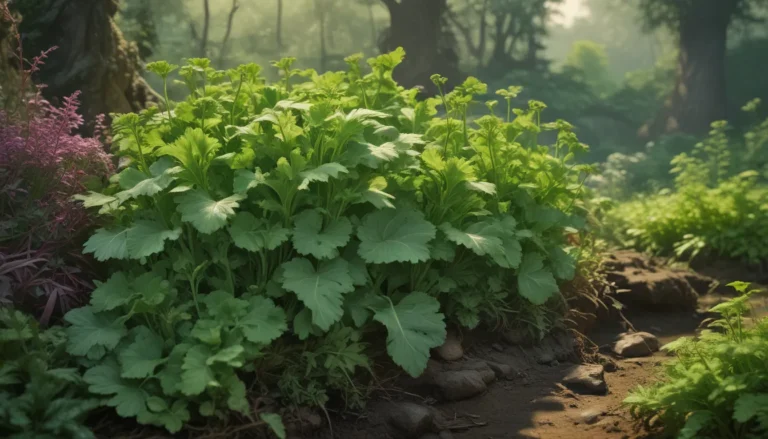How to Harvest Mustard Greens like a Pro: A Comprehensive Guide

If you are someone who loves fresh, leafy greens straight from your garden, then there’s nothing quite like growing your very own mustard greens. These nutritious vegetables are not only easy to cultivate but also offer a flavorful addition to your meals.
Unlike many other vegetables that require patience before being ready for harvest, mustard greens demand a different approach. They need diligence, attention to detail, and a timely picking schedule to ensure you get the best out of your crop.
Whether you’re growing microgreens, baby leaves, or full-size varieties like ‘Ruby Streaks’ or ‘Red Giant,’ staying on top of their growth progression is crucial. From sowing to harvesting, each step requires attention and care to get the best results from your mustard plants.
Let’s dive into the nitty-gritty details of harvesting mustard greens, ensuring you pick the freshest, most flavorful leaves every time.
What You’ll Learn
- Understanding Your Mustard Variety
- Harvesting Mustard Microgreens
- Picking Baby Leaves
- Tips for Broadleaf Varieties
- Ways to Extend the Harvest
Understanding Your Mustard Variety
Before diving into the harvesting process, it’s essential to understand the variety of mustard greens you’re growing. Mustard greens belong to the Brassicaceae family, with different species like Brassica juncea, B. rapa, B. nigra, B. hirta, or Sinapis alba.
Each variety has its unique characteristics, growth patterns, and flavor profiles. Some, like mizuna or tatsoi, are more heat-tolerant and ideal for growing in warmer climates, while others, like ‘Red Giant’ or ‘Southern Curled,’ can withstand colder temperatures.
When selecting your seeds, be sure to check the days to maturity, heat tolerance, and intended use for the variety you’re planting. Understanding these factors will help you plan your harvest schedule and maximize the yield of your mustard greens.
Harvesting Mustard Microgreens
For those looking to enjoy the delicate, tender leaves of mustard greens, harvesting them at the microgreen stage is a delightful experience. Once the seedlings have formed their first true leaves, you can start picking them for consumption.
Simply uproot the seedlings gently, give them a rinse, and enjoy them fresh in salads, soups, or as a pizza topping. If you have an abundance of microgreens, air dry them, and store them in the fridge for up to three days.
It’s essential to separate your microgreens from the plants you intend to grow to full size to avoid accidental uprooting during harvest. A little extra care in maintaining separate growing spaces can make a significant difference in your harvesting process.
Picking Baby Leaves
When it comes to harvesting baby leaves of your mustard greens, precision is key. The optimal size for baby leaves varies depending on the variety you’re growing. Broadleaf varieties like ‘Green Wave’ or ‘Red Giant’ are best harvested between one and two inches tall for fresh eating.
Use sterile scissors or a paring knife to clip the outer leaves or cut the entire plant about an inch from the crown. By sampling a few leaves before harvesting a bulk, you can ensure the best flavor and texture for your salads or wraps.
For those aiming to let the plant continue growing while also enjoying baby leaves, strategic harvesting is essential. Cut the outer leaves or trim the entire plant, leaving room for new growth to emerge.
Tips for Broadleaf Varieties
The larger, broadleaf varieties of mustard greens offer a robust, peppery flavor that pairs well with slow-cooked dishes. When harvesting these leaves, timing is crucial to ensure a bountiful yield for cooking or freezing.
Harvest the outer leaves of the broadleaf varieties using scissors or a knife, leaving room for new growth to emerge. Timing the harvest to coincide with a large batch of leaves ready for cooking or preserving is key to making the most out of your harvest.
Additionally, consider freezing the leaves for later use by blanching them and storing them in the freezer. Proper planning and execution can help you enjoy the flavors of mustard greens throughout the winter months.
Ways to Extend the Harvest
For those looking to extend their harvest of mustard greens, there are several strategic approaches to consider. Successive planting, starting seeds indoors for early planting, and providing shade to prevent bitterness in warmer months are effective strategies to prolong your harvest.
By planting new seeds every few weeks, you can ensure a consistent supply of fresh greens without overwhelming your kitchen. Additionally, planting mustard greens indoors as microgreens offers a quick, on-demand harvest year-round.
Maintaining proper care, watering, and shading for your mustard plants can help you enjoy fresh, flavorful greens throughout the growing season. With a little planning and attention to detail, you can savor the taste of mustard greens for months to come.
Harvest Mustard Greens for Many Moons
Growing and harvesting mustard greens can be a rewarding experience for any gardener. From their nutritious benefits to the culinary versatility they offer, mustard greens are a delightful addition to any garden.
By mastering the art of harvesting mustard greens at different stages, understanding your variety’s unique characteristics, and planning your harvest schedule strategically, you can enjoy a continuous supply of fresh greens year-round.
If you found this guide valuable, be sure to check out our other articles on mustard greens, including health benefits, companion planting, pest management, and the best varieties to grow in your garden.
For more tips, tricks, and insights into growing mustard greens, we invite you to share your thoughts and questions in the comments below. Happy harvesting!
In conclusion, harvesting mustard greens is not just about picking leaves; it’s an art form that requires attention, planning, and care. By understanding your variety, mastering the art of harvesting at different stages, and strategizing to extend your harvest, you can enjoy the fresh flavors of mustard greens year-round. Happy harvesting!





